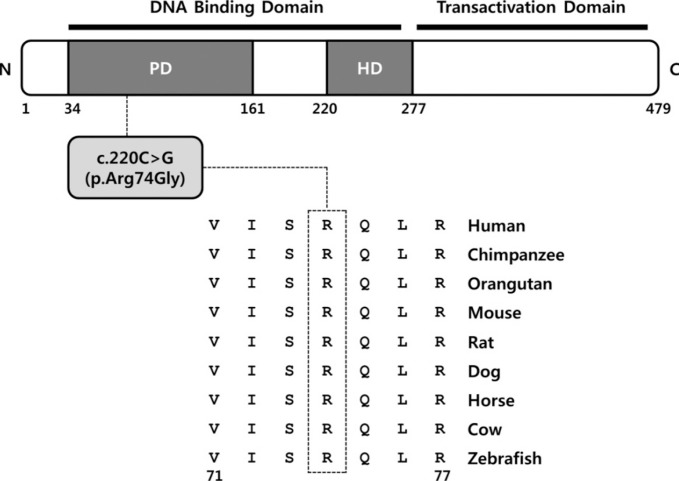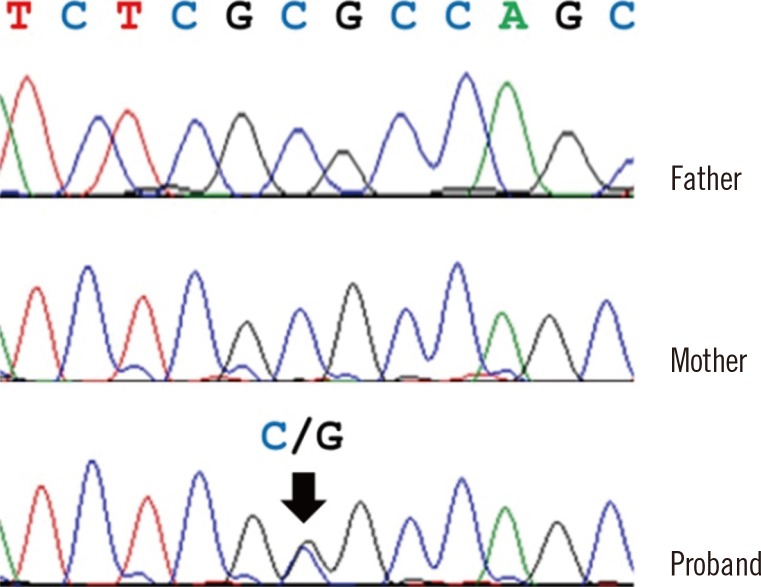Identification of a Novel De Novo Variant in the PAX3 Gene in Waardenburg Syndrome by Diagnostic Exome Sequencing: The First Molecular Diagnosis in Korea
- Affiliations
-
- 1Department of Laboratory Medicine and Genetics, Samsung Medical Center, Sungkyunkwan University School of Medicine, Seoul, Korea. changski@skku.edu
- 2Green Cross Genome, Yongin, Korea. ehcho@greencross.com
- KMID: 2363211
- DOI: http://doi.org/10.3343/alm.2015.35.3.362
Abstract
- Waardenburg syndrome (WS) is a clinically and genetically heterogeneous hereditary auditory pigmentary disorder characterized by congenital sensorineural hearing loss and iris discoloration. Many genes have been linked to WS, including PAX3, MITF, SNAI2, EDNRB, EDN3, and SOX10, and many additional genes have been associated with disorders with phenotypic overlap with WS. To screen all possible genes associated with WS and congenital deafness simultaneously, we performed diagnostic exome sequencing (DES) in a male patient with clinical features consistent with WS. Using DES, we identified a novel missense variant (c.220C>G; p.Arg74Gly) in exon 2 of the PAX3 gene in the patient. Further analysis by Sanger sequencing of the patient and his parents revealed a de novo occurrence of the variant. Our findings show that DES can be a useful tool for the identification of pathogenic gene variants in WS patients and for differentiation between WS and similar disorders. To the best of our knowledge, this is the first report of genetically confirmed WS in Korea.
Keyword
MeSH Terms
-
Adult
Amino Acid Sequence
Asian Continental Ancestry Group/genetics
Base Sequence
DNA/chemistry/genetics/metabolism
Exons
Humans
Male
Mutation, Missense
PAX3 Transcription Factor/*genetics
Phenotype
Polymorphism, Single Nucleotide
Republic of Korea
Sequence Analysis, DNA
Waardenburg Syndrome/*diagnosis/genetics
DNA
PAX3 Transcription Factor
Figure
Cited by 3 articles
-
Identification of Compound Heterozygous EYS Variants in a Korean Patient with Retinitis Pigmentosa
Hyoung-Tae Kim, Ja Hyun Jang, Kyungeun Kang, Chang-Seok Ki, Hyewon Chung
Lab Med Online. 2018;8(2):66-70. doi: 10.3343/lmo.2018.8.2.66.Novel Mutation (c.8725T>C) in Two Siblings With Late-Onset LAMA2-Related Muscular Dystrophy
Min-Wook Kim, Dae-Hyun Jang, Jun Kang, Seungok Lee, Sun Young Joo, Ja-Hyun Jang, Eun-Hae Cho, Young-Chul Choi, Jung Hwan Lee
Ann Lab Med. 2017;37(4):359-361. doi: 10.3343/alm.2017.37.4.359.Identification of a Heterozygous
SPG11 Mutation by Clinical Exome Sequencing in a Patient With Hereditary Spastic Paraplegia: A Case Report
Ja-Young Oh, Hyun Jung Do, Seungok Lee, Ja-Hyun Jang, Eun-Hae Cho, Dae-Hyun Jang
Ann Rehabil Med. 2016;40(6):1129-1134. doi: 10.5535/arm.2016.40.6.1129.
Reference
-
1. Pingault V, Ente D, Dastot-Le Moal F, Goossens M, Marlin S, Bondurand N. Review and update of mutations causing Waardenburg syndrome. Hum Mutat. 2010; 31:391–406. PMID: 20127975.
Article3. Pardono E, van Bever Y, van den Ende J, Havrenne PC, Iughetti P, Maestrelli SR, et al. Waardenburg syndrome: clinical differentiation between types I and II. Am J Med Genet A. 2003; 117A:223–235. PMID: 12599185.
Article4. Wildhardt G, Zirn B, Graul-Neumann LM, Wechtenbruch J, Suckfüll M, Buske A, et al. Spectrum of novel mutations found in Waardenburg syndrome types 1 and 2: implications for molecular genetic diagnostics. BMJ Open. 2013; 3:e001917.
Article5. Farrer LA, Grundfast KM, Amos J, Arnos KS, Asher JH Jr, Beighton P, et al. Waardenburg syndrome (WS) type I is caused by defects at multiple loci, one of which is near ALPP on chromosome 2: first report of the WS consortium. Am J Hum Genet. 1992; 50:902–913. PMID: 1349198.6. Ouyang XM, Yan D, Yuan HJ, Pu D, Du LL, Han DY, et al. The genetic bases for non-syndromic hearing loss among Chinese. J Hum Genet. 2009; 54:131–140. PMID: 19197336.
Article7. Choi JH, Moon SK, Lee KH, Lew HM, Chang YH. Three Cases of Waardenburg syndrome type 2 in a Korean family. Korean J Ophthalmol. 2004; 18:185–189. PMID: 15635834.
Article8. Kee SY, Lee YC, Lee SY. Type 3 Waardenburg syndrome. J Korean Ophthalmol Soc. 2005; 46:726–730.9. Lee SC. A case of Waardenburg syndrome type 2 with anisocoria. J Korean Ophthalmol Soc. 2010; 51:1423–1426.
Article10. Shim HC, Kim JK, Park DJ. A case of Waardenburg syndrome type 4. J Korean Ophthalmol Soc. 2013; 54:176–179.
Article11. Lohmann K, Klein C. Next generation sequencing and the future of genetic diagnosis. Neurotherapeutics. 2014; 11:699–707. PMID: 25052068.
Article12. Gomez CM, Das S. Clinical exome sequencing: the new standard in genetic diagnosis. JAMA Neurol. 2014; 71:1215–1216. PMID: 25133783.14. Matsunaga T, Mutai H, Namba K, Morita N, Masuda S. Genetic analysis of PAX3 for diagnosis of Waardenburg syndrome type I. Acta Otolaryngol. 2013; 133:345–351. PMID: 23163891.
- Full Text Links
- Actions
-
Cited
- CITED
-
- Close
- Share
- Similar articles
-
- Identification of a De Novo Heterozygous Missense FLNB Mutation in Lethal Atelosteogenesis Type I by Exome Sequencing
- Novel Pathogenic Variant (c.3178G>A) in the SMC1A Gene in a Family With Cornelia de Lange Syndrome Identified by Exome Sequencing
- Three Cases of Waardenburg Syndrome Type 2 in a Korean Family
- Identification of a likely pathogenic variant of YY1 in a patient with developmental delay
- Whole-exome sequencing analysis in a case of primary congenital glaucoma due to the partial uniparental isodisomy



